#st brigid of ireland
Explore tagged Tumblr posts
Text

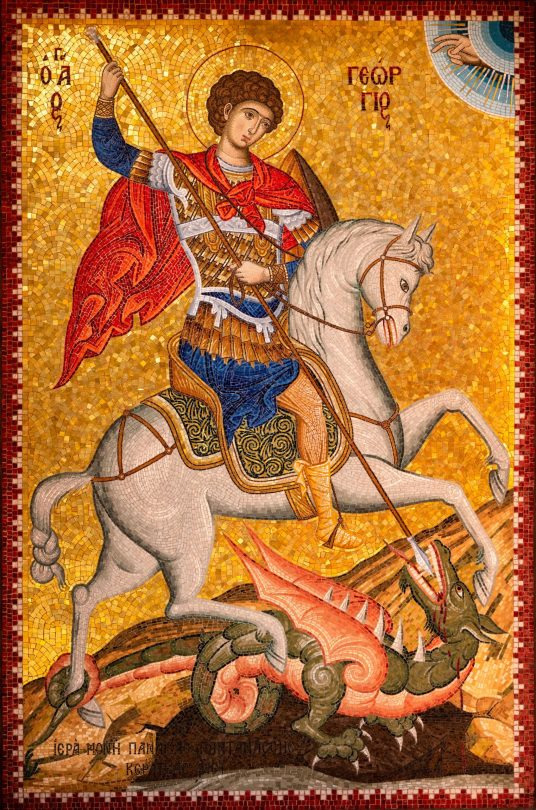
About St Brigid of Ireland
About St George
Losers' Bracket Round 3
#st brigid of ireland#st george#st george the dragon slayer#catholic saint tournament#catholic#tumblr tournament#tumblr bracket#theology#tumblr polls#polls#christianity#catholic saints#catholicism
25 notes
·
View notes
Text









St Brigid's Crosses from the National Museum of Ireland Country Life collection
#st brigid#imbolc#imbolg#st brigid's day#ireland#happy first day of spring everybody 🌿🌼🐑 grma brigid 🙏
2K notes
·
View notes
Text

#artists on tumblr#my art#ireland#irish mythology#imbolc#st brigid's cross#st brigid's day#wheel of the year#gaelpol#pagan#irish polytheism#watercolour illustration#ostara
289 notes
·
View notes
Text
St Brigid (Naomh Bríd) really is a fantastic example of how Ireland thrives on the pagan aspects of its Catholicism. Yes she’s a catholic saint yes her feast day is the pagan festival for the beginning of spring. We will make a bank holiday about of it. Children will make crosses out of reeds at school and mass will be said and this all works beautifully alongside each other. The church has done a lot of bad but yet it can still be part of something good; we can reclaim our roots despite few people being pagan nowadays.
#this is probably true for many other places also#another example is st stephen’s day and the wren though it’s a lot less acknowledged now (and no one kills a wren)#my own post#obviously there’s also oíche samhna and all soul’s day but that nearly feels targeted#*oíche shamhna#ireland#I know there are pagans - one of my close friends is - but it no longer a predominant religion or lifestyle.#st brigid#naomh bríd
72 notes
·
View notes
Text
Excerpts from Ronald Hutton’s Stations of the Sun on Folk Practices Concerning St. Brigid
Interspersed are photos of my own Brigid Dollies, beds, and crosses.









#brigid#brighid#st brigid#st brighid#folk christianity#brigid bed#brigid doll#brigid cross#corn dolly#ireland#irish#isle of man#Hebrides#ronald hutton#stations of the sun#Scotland
34 notes
·
View notes
Text

Lá Fhéile Bríde 🍃☘️
#st brigid#brigid#imbolc#irish art#ireland#irish mythology#illustration#artists on tumblr#my art#art#digital art#artist
38 notes
·
View notes
Text
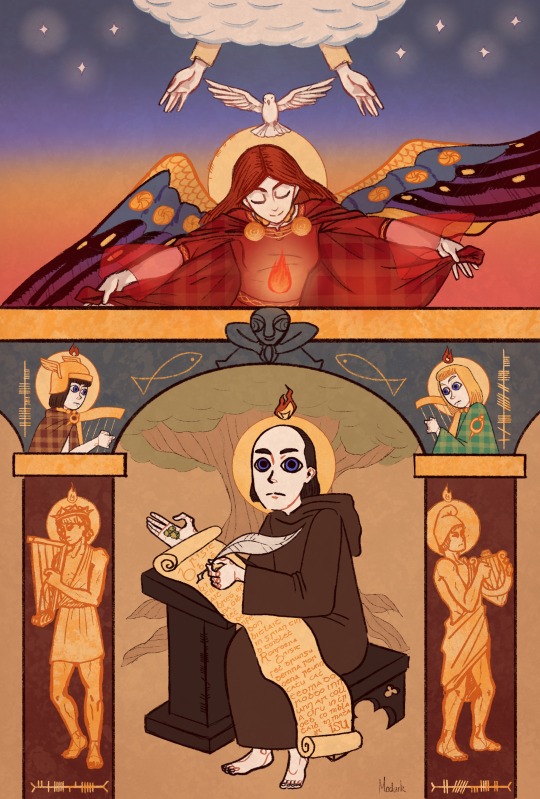
The Bardic Tradition
I made a long thread explaining in detail all the symbolism in this piece when I first posted it. That's lost to time now, thanks Elon. I'll try to rewrite it to the best of my ability in an abridged form.
The basic gist is that its a visual representation of the ancient Gaelic bardic tradition. Seated in the center is St. Colmcille, composing an old Irish hymn to St. Brigid, "Brigit bé bithmaith". He is holding hazel nuts, symbols of knowledge / inspiration in Irish legend. On the two pillars on either side of him are King David (left) and Orpheus (right), two famous poets from antiquity. Two legendary poets from Irish legend, Oisín and Amergin, are situated above each pillar respectively. The two fish are seen swimming "upstream" (as in the legend of the Salmon of Knowledge) toward a sheela na gig, a architectural feature / grotesque of early Irish churches which some consider to be symbols of femininity, meant to ward off evil. At the top of the image, hands from a cloud (representing God) release a white dove (representing the Holy Spirit) down to St. Brigid. She owes her angelic appearance to her being considered both a pagan goddess and Christian saint. She is guarding a flame, which symbolises poetic inspiration, and which can be seen floating above the heads of all the other figures.
#celtic#irish#poetry#celtic mythology#irish mythology#irish culture#ireland#celtic culture#celtic christianity#druidry#druidism#bardic inspiration#imbas#imbas forosnai#celtic revival#gaelic#st brigid#saint brigid#mythology#digital art#mediaeval#medieval art#medieval manuscripts#illuminated manuscript#celtic design#irish history#awen#esotericism#spirituality#paganism
125 notes
·
View notes
Text

Happy Brigid's Day, my loves.
A day to celebrate the Celtic goddess Brigid, later St Brigid, and Imbolc. Brigid is the goddess of female empowerment, fertility, and creativity.
Imbolc celebrates the end of the darkness of winter and the arrival of the lighter days that come with spring (aka 'the grand stretch', as it's known in Ireland).
Artwork by @fionab_art
74 notes
·
View notes
Text

February 1, 2025
Saint Brigid/Bride of Kildare
O God, whose servant Brigid, kindled with the flame of thy love, became a shining light in thy Church: Grant that we also may be aflame with the spirit of love and discipline, and walk before thee as children of light; through Jesus Christ our Lord, who liveth and reigneth with thee, in the unity of the Holy Ghost, one God, now and for ever. Amen.
Saint Brigid, may all those who fear persecution look toward your beacon of light through these cold, dark days of the season and of this nation. May your fire kindle within us a fire of justice that burns with a passion for the poor, the oppressed, and the sick. May your light guide us into the care of our loving and merciful Creator. Amen.
#anglican#episcopalian#anglican church#christianity#episcopal church#saint#saints#christian faith#orthodox#Catholic#irish#brigid#bride#saint brigid#kildare#brigid of kildare#st brigid#flame#light#jesus#god#justice#fire#February#Ireland
11 notes
·
View notes
Text
Brigid of Kildare- Saint and Ordained Woman Bishop

In iconography, a shepherd's staff or crozier is used to indicate the status of a bishop. As it stands in the Catholic church, the ordination is only given to men by men. However, St. Brigid has a contrary story. I couldn't explain it better than this article.
#folk catholicism#catholic#catholicism#st brigid#irish history#irish folklore#ireland#irish#womens ordination#women#history#historical women#saints#saint stories#christianity#catholic women#christian women#ordination#feminism
15 notes
·
View notes
Text
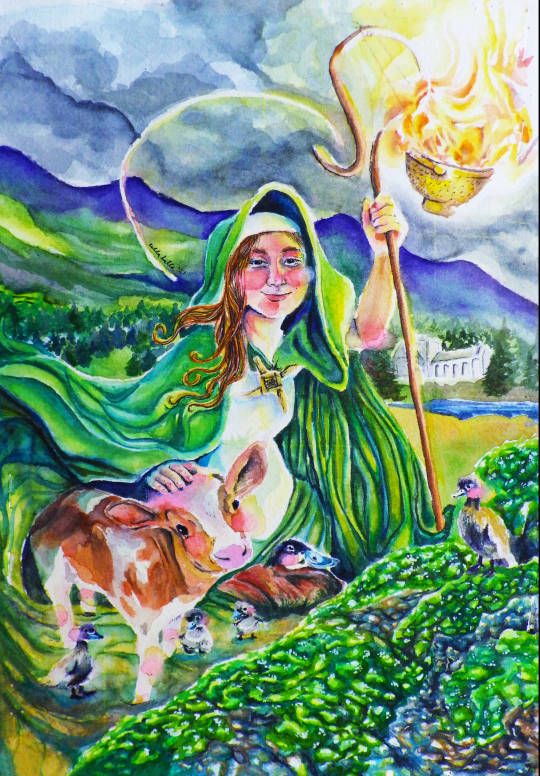
Happy feast day, St. Brigid!
#feast day#st. brigid of kildare#catholic#irish#saint#art print#art#catholic art#ducks#baby cow#calf#ireland#green#baby duckies#st. brigid's cross#art sale
61 notes
·
View notes
Text
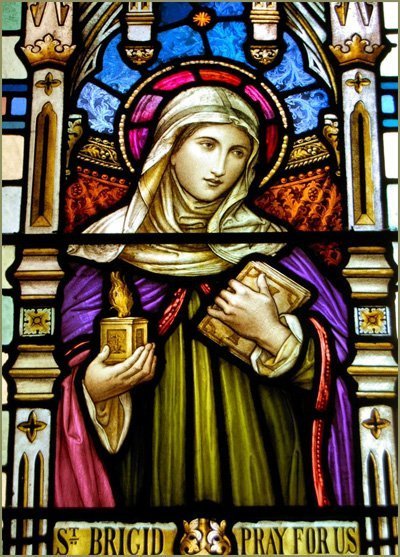
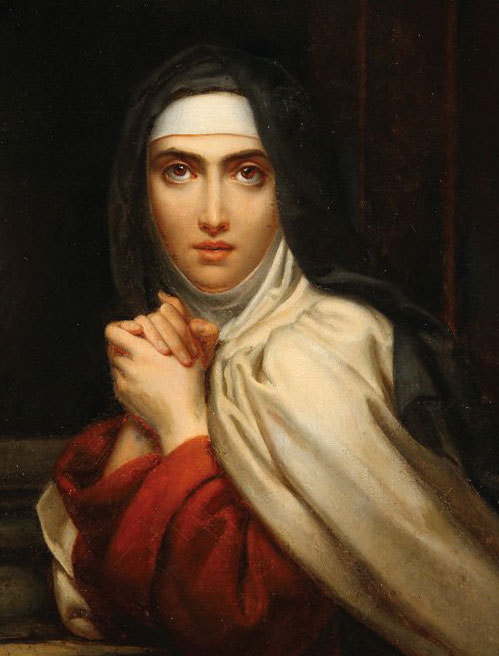
About St Brigid of Ireland
About St Teresa of Avila
Losers' Bracket Round 2
#st brigid#st brigid of ireland#st teresa of avila#catholic saint tournament#catholic#catholicism#catholic saints#christianity#polls#tumblr tournament#tumblr bracket#theology#tumblr polls
30 notes
·
View notes
Text
Today is St Brigid's day. Imbolc, the start of the celtic spring. As is traditional, I made some St Brigid's crosses out of rushes.

56 notes
·
View notes
Text
Brigit the Fire-Goddess
"In our own country [i.e., the United Kingdom of Great Britain and Ireland] perpetual fires were maintained in the temple of a goddess whom the Romans identified with Minerva, but whose native Celtic name seems to have been Brigit. Like Minerva, Brigit was a goddess of poetry and wisdom, and she had two sisters also called Brigit, who presided over leechcraft and smithcraft respectively. This appears to be only another way of saying that Brigit was the patroness of bards, physicians, and smiths.
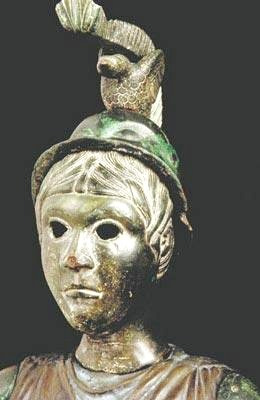
Brigit, goddess of Menez-hom, Celto-Roman art (1st century CE)
(Source: Museum of Brittany, CC BY-SA 3.0 https://creativecommons.org/licenses/by-sa/3.0, via Wikimedia Commons)
Now, at Kildare in Ireland the nuns of St. Brigit tended a perpetual holy fire down to the suppression of the monasteries under Henry VIII.; and we can hardly doubt that in doing so they merely kept up, under a Christian name, an ancient pagan worship of Brigit in her character of a fire-goddess or patroness of smiths. The nuns were nineteen in number. Each of them had the care of the fire for a single night in turn; and on the twentieth evening the last nun, having heaped wood on the fire, used to say, 'Brigit, take charge of your own fire; for this night belongs to you.' She then went away, and next morning they always found the fire still burning and the usual quantity of fuel consumed. Like the Vestal fire at Rome in the old days, the fire of St. Brigit burned within a circular enclosure made of stakes and brushwood, and no male might set foot inside the fence. The nuns were allowed to fan the fire or blow it up with bellows, but they might not blow on it with their breath....
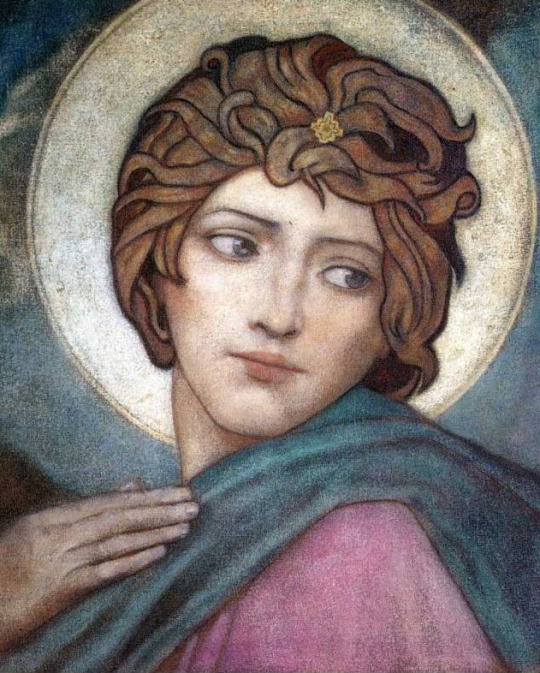
Study for St. Bride (c. 1917), by John Duncan.
(Source: John Duncan, Public domain, via Wikimedia Commons)
The custom of maintaining a perpetual fire was not peculiar to Kildare, but seems to have been common in Ireland, for the native records shew that such fires were kept up in several monasteries, in each of which a small church or oratory was set apart for the purpose. This was done, for example, at the monasteries of Seirkieran, Kilmainham, and Inishmurray. We may conjecture that these holy fires were merely survivals of the perpetual fires which in pagan times had burned in honour of Brigit. The view that Brigit was a fire-goddess is confirmed by the observation that in the Christian calendar her festival falls the day before Candlemas, and the customs observed at that season by Celtic peasantry seem to prove that she was a goddess of the crops as well as of fire. If that was so, it is another reason for comparing her to Vesta, whose priestesses performed ceremonies to fertilise both the earth and the cattle. Further, there are some grounds for connecting Brigit, like Vesta, with the oak; for at Kildare her Christian namesake, St. Brigit, otherwise known as St. Bride or St. Bridget, built her church under an oak-tree, which existed till the tenth century, and gave its name to the spot, for Kildare is Cilldara, 'the church of the oak-tree.' The 'church of the oak' may well have displaced a temple or sanctuary of the oak, where in Druidical days the holy fire was fed, like the Vestal fire at Rome, with the wood of the sacred tree."
—J. G. Frazer, The Magic Art & the Evolution of Kings, part 2 (The Golden Bough, vol. II, 1911, pp. 240-242).

The Coming of Bride (1917), by John Duncan.
(Source: John Duncan (1866-1945), Public domain, via Wikimedia Commons)
#brigit#bride#bridget#st. brigit#minerva#poetry#wisdom#bards#physicians#smiths#vesta#fire#fire-goddess#Ireland#united kingdom#kildare#candlemas#paganism#oak tree#druids#celtic#irish mythology#jg frazer#the golden bough#the golden bough vol ii#brigid#pagan survivals
9 notes
·
View notes
Text




Happy St. Brigid’s Day! Happy Imbolc!
This festival is the feast day for the patroness Saint of Ireland, although dates back to Pagan times, and marks the first day of Spring and the begining of the new farm year. Usual traditions of the festival include weaving St Brigid’s crosses from rushes, visiting holy wells and making a Brídeóga- a doll of Brigid. In local communities the Brídeóga would be carried by ‘Biddy Boys’ who wear masks of straw and parade the doll through the town, playing folk music and ask for a ‘penny for the Biddy.’ If there was no money in the household, a pin was stuck in the biddy instead.
Photos by Homer Sykes, taken in Killorgan, Co.Kerry, 1972. Via Café Royal Books.
9 notes
·
View notes